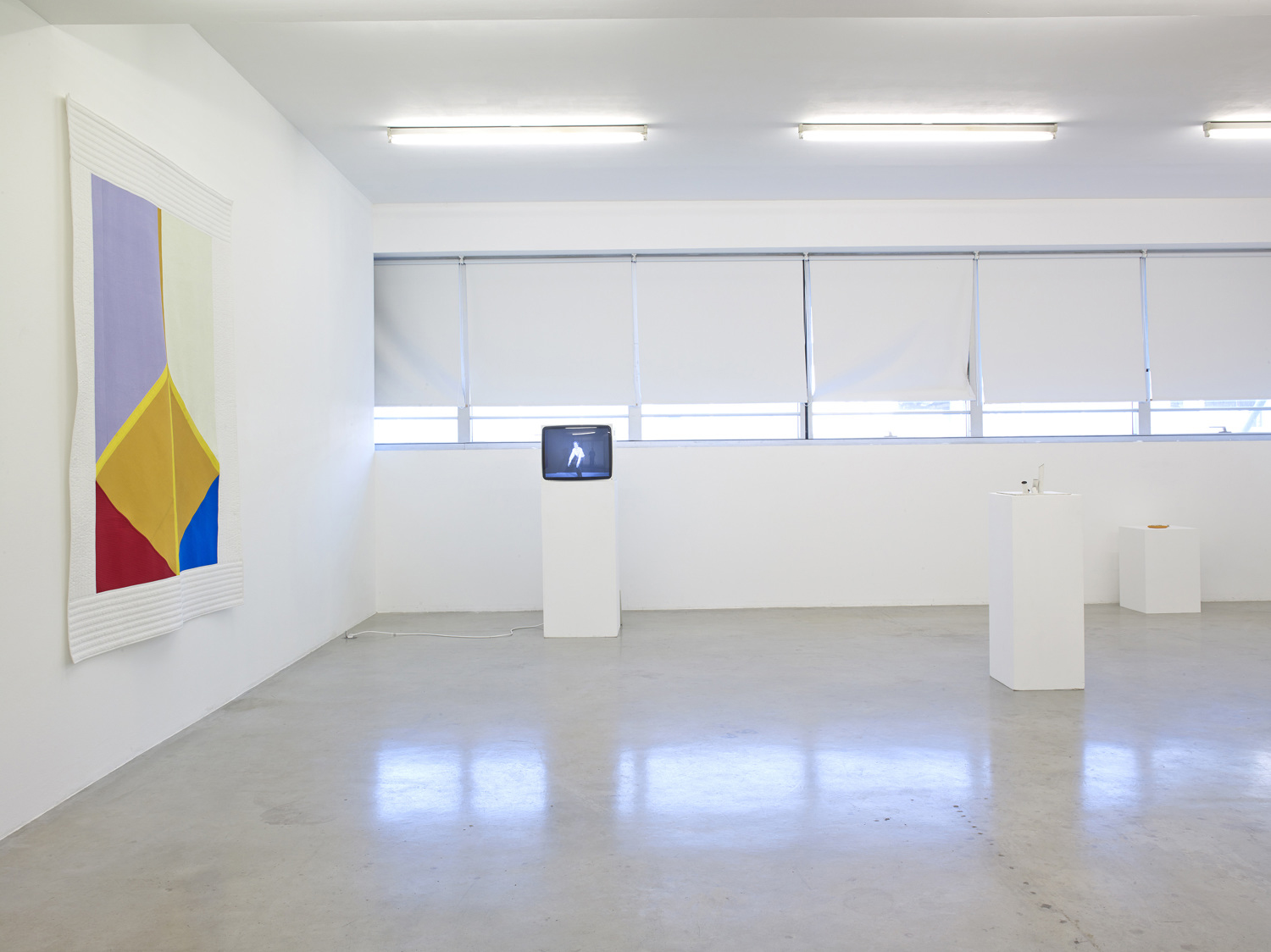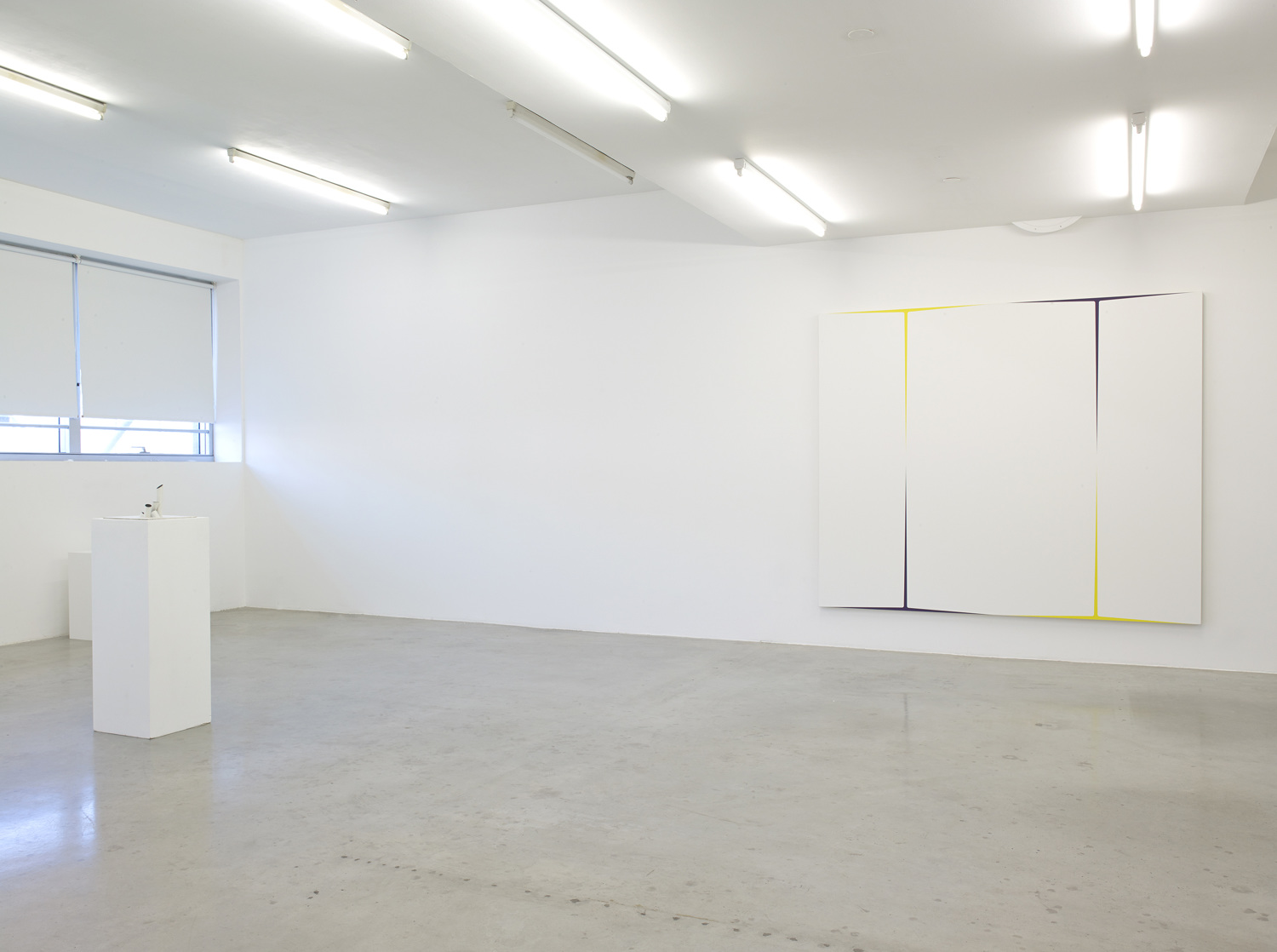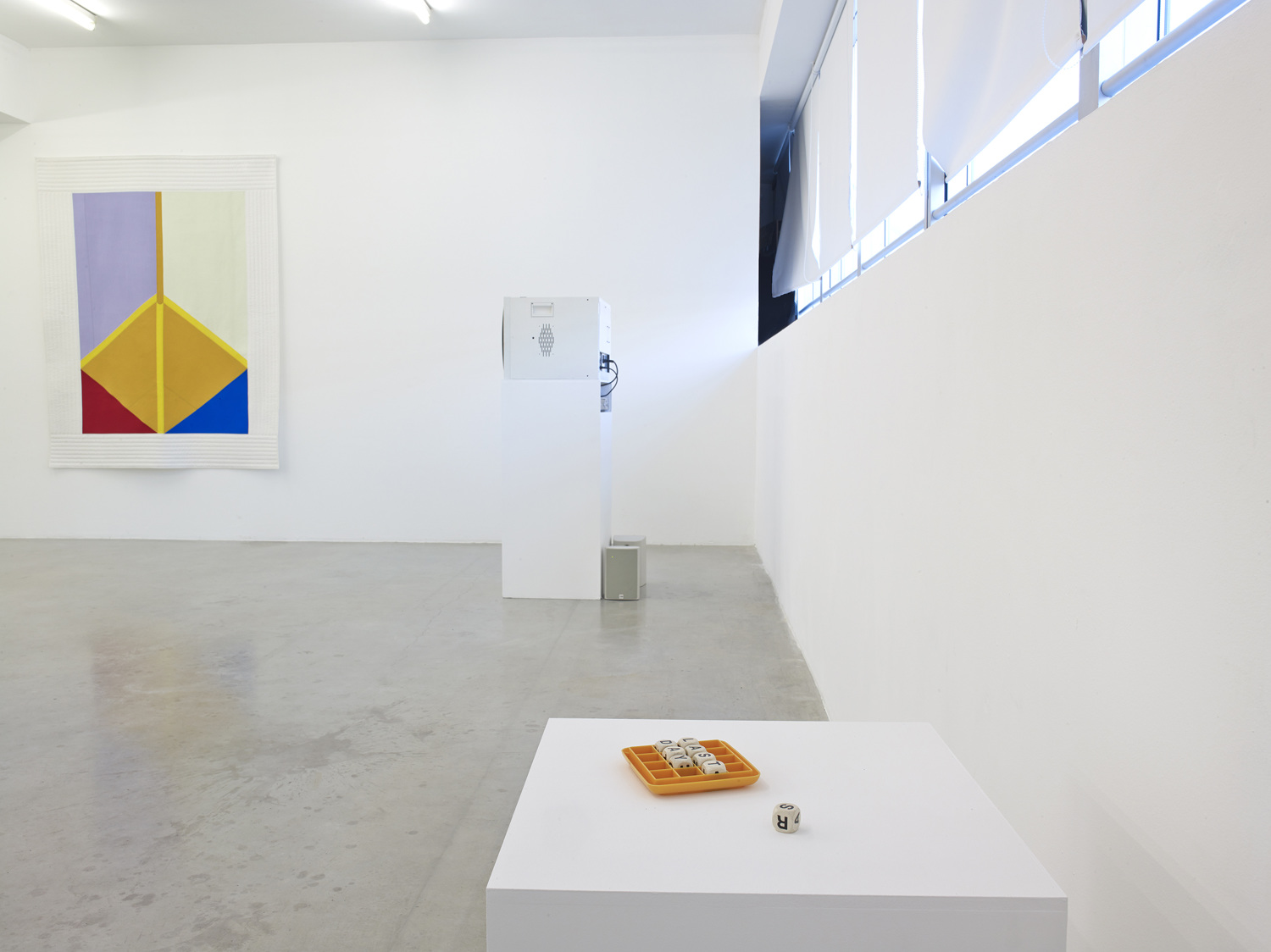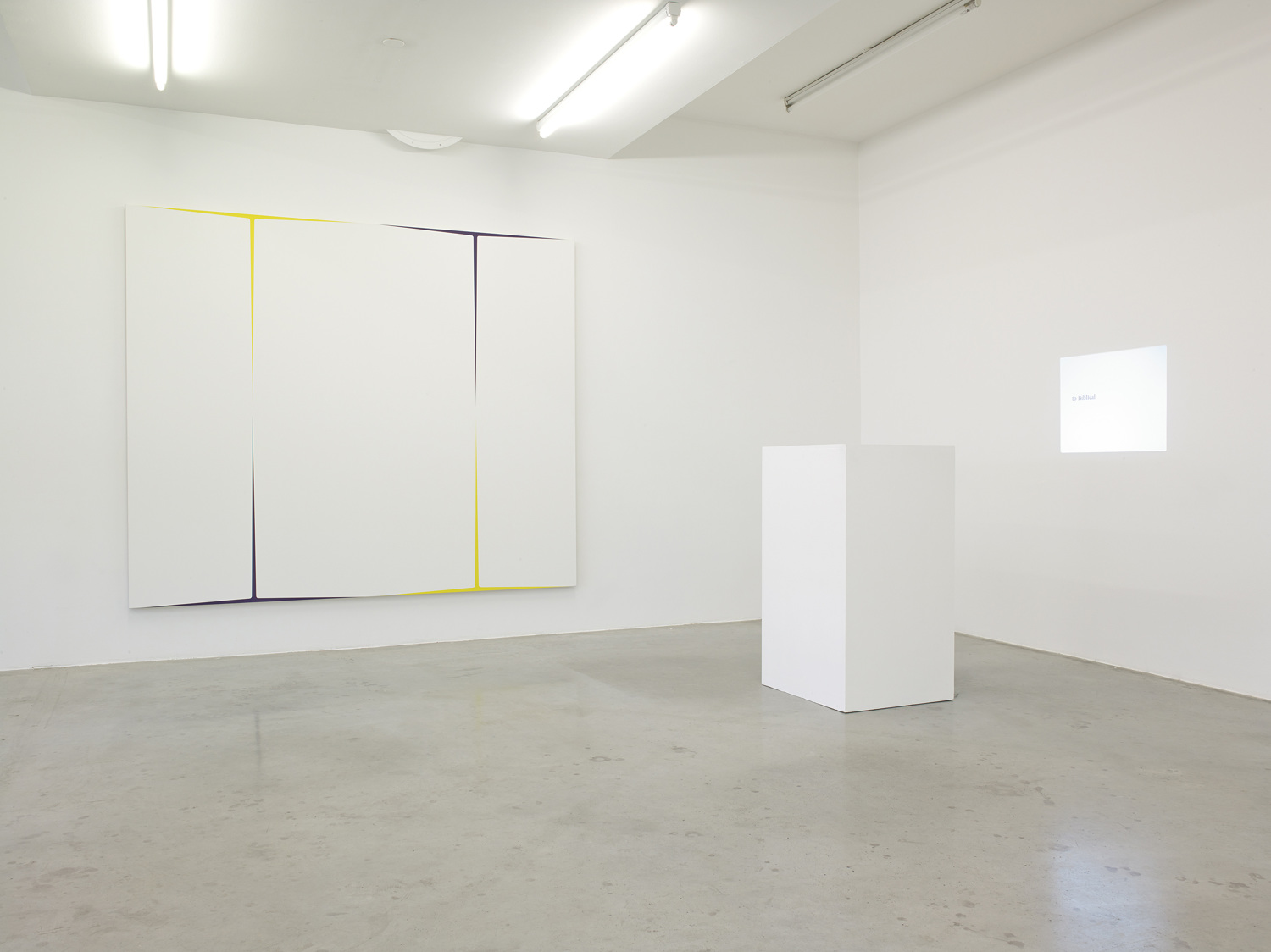N a pris les dés
Guy de Cointet, Stéphane Dafflon, Noa Giniger, Seulgi Lee, Camila Oliveira Fairclough, Hanna Schwarz
Air de Paris, 2015
Courtesy the artists and Air de Paris, Paris. Photo © Marc Domage.
![]()
![]()
![]()
![]()
« N a pris les dés » emprunte son titre à la version aléatoire et anagrammatique du premier film couleur d’Alain Robbe-Grillet et propose une nouvelle fois de poursuivre son jeu vertigineux de compositions infinies et fantasmatiquement labyrinthiques (1). Ce film double est sans doute l’une de ses œuvres les plus abouties, tant elle est graphiquement et formellement impeccable et tant chaque plan ou image appréhendé séparément reste toujours aussi superbe. Oui, répond-t-il d’un sourire amusé. C’est mon premier film en couleurs. C’est très important pour moi, la découverte de la couleur. Il avait été question qu’on m’impose la couleur pour « L’homme qui ment » et j’avais refusé absolument. Parce que j’ai dit non, c’est impossible, toute cette forêt là. Verte. [...] J’avais eu une sorte de révélation que je pouvais faire un film en couleurs à condition qu’il n’y ait pas de vert (2). Voici à présent démasquée, l’absence qui confère au film sériel tout comme au film aléatoire son aspect pictural si particulier et même les quelques palmiers s’avèrant plutôt être des dattiers finissent par se couvrir de poussière et de sable à la fin de l’été, leur donnant ainsi un aspect davantage zingué (3). Ajouter à cela, une lumière éblouissante, l’absence d’ombres comme le tournage eut lieu aux heures zénitales et tous les villages repeints en blanc et bleu sur les ordres du régime néo-destourien. Sans oublier, l’ingrédient principal qui n’est autre que la voix du narrateur confiant le déroulement du film au hasard des dés, auquel s’ajoute la parole de Catherine Jourdan rétablissant la narration en nous faisant part d’une sombre histoire de composition abstraite non lyrique égarée. Dans ce pastiche de film d’aventure retenant sans cesse son récit afin de le rendre impossible, il est surtout et avant tout question de peinture et notamment à travers la recherche d’un tableau dont l’esthétique néo-plastique fut hâtivement attribuée à Mondrian – avec qui Alain Robbe-Grillet partage un certain désaveu du vert – pour finalement être associé au magnétisme des compositions de Malevitch. Et si cette peinture, reflet d’une maison dont les contours ont disparu sous le ciel écrasant, venait elle-aussi hanter la présente exposition ?
2. Entretien avec Frédéric Taddéi, « L’Eden et après », DVD, Alain Robbe-Grillet, 1972, couleurs, 76 minutes, éditions Carlotta, 2013.
3. Le tournage s’est déroulé dans les villes de Djerba et sur les bords du Danube à Bratislava. Afin de parfaire cette duplication, Alain Robbe-Grillet a pris soin de retrouver le double parfait de chaque lieu créant par la même occasion une forme de passage tel un espace paradoxal apparaissant habituellement dans les rêves.
//
"N a pris les dés" borrows its title from the aleatory, anagrammatic "L’Eden et après", the first film in colour by Alain Robbe-Grillet. The exhibition sets out to continue the film's dizzying compositional interweaving of endlessly labyrinthine fantasies (4). This dual film is doubtless one of Robbe-Grillet's most accomplished: graphically and formally it is flawless and each individual shot or image remains as magnificent as ever."Yes," he smilingly recounts, "it was my first colour film. The discovery of colour was really something for me. They'd tried to make me use it for "L’homme qui ment", and I refused point blank. I said no, it's impossible, all that forest. All that green . . . Later I had a revelation: I could make a film in colour as long as there was no green in it (5).Thus stands revealed the absence that gives both the serial film and the aleatory one their highly distinctive pictorial look; even the palms – which turn out to be date-palms – finish up covered in dust and sand by the end of summer, making them look more zinc-plated (6). Add to this the dazzling light, the absence of shadows – the shooting was done when the sun was directly overhead – and all the villages painted blue and white on orders from Tunisia's Neo-Destour regime. Not to mention the main ingredient: none other than the narrator's voice explaining the unfolding of the film according to the throws of the dice, plus Catherine Jourdan verbally putting the narrative back together by recounting a mysterious story of an abstract painting gone astray. In this pastiche of an adventure movie that constantly withholds its story so as to make it impossible, the crucial issue is painting: painting approached through a search for a picture whose neo-plastic aesthetic brings a hasty attribution to Mondrian – with whom Robbe-Grillet shares a certain aversion for green – before finally being associated with the magnetism of Malevich. And what if this painting, the reflection of a house whose contours have vanished under the crushing sunlight, were also haunting this exhibition?
Arlène Berceliot Courtin
-
4. "L’Eden et apr̀és" comprises twelve themes spread over ten successive series. The second film commissioned by ORTF (French state television) in 1972 was titled "N. a pris les dés"...; it was the upshot of a new, random combination of these same themes, whose order of appearance is governed by throws of the dice by the narrator, known as "N". The first appearance took place between 1–4 May 2015 in the studio of Camila Oliveira Fairclough in Paris.
5.Interview with Frédéric Taddéi, "L’Eden et après", DVD, Alain Robbe-Grillet, 1972, colour, 76 minutes, Editions Carlotta, 2013.
6. The film was shot in villages in Djerba and on the banks of the Danube, in Bratislava. To ensure exact replication, Robbe-Grillet scrupulously found the perfect double for each place, and in doing so created a kind of paradoxical interspace usually to be found in dreams.
Courtesy the artists and Air de Paris, Paris. Photo © Marc Domage.




« N a pris les dés » emprunte son titre à la version aléatoire et anagrammatique du premier film couleur d’Alain Robbe-Grillet et propose une nouvelle fois de poursuivre son jeu vertigineux de compositions infinies et fantasmatiquement labyrinthiques (1). Ce film double est sans doute l’une de ses œuvres les plus abouties, tant elle est graphiquement et formellement impeccable et tant chaque plan ou image appréhendé séparément reste toujours aussi superbe. Oui, répond-t-il d’un sourire amusé. C’est mon premier film en couleurs. C’est très important pour moi, la découverte de la couleur. Il avait été question qu’on m’impose la couleur pour « L’homme qui ment » et j’avais refusé absolument. Parce que j’ai dit non, c’est impossible, toute cette forêt là. Verte. [...] J’avais eu une sorte de révélation que je pouvais faire un film en couleurs à condition qu’il n’y ait pas de vert (2). Voici à présent démasquée, l’absence qui confère au film sériel tout comme au film aléatoire son aspect pictural si particulier et même les quelques palmiers s’avèrant plutôt être des dattiers finissent par se couvrir de poussière et de sable à la fin de l’été, leur donnant ainsi un aspect davantage zingué (3). Ajouter à cela, une lumière éblouissante, l’absence d’ombres comme le tournage eut lieu aux heures zénitales et tous les villages repeints en blanc et bleu sur les ordres du régime néo-destourien. Sans oublier, l’ingrédient principal qui n’est autre que la voix du narrateur confiant le déroulement du film au hasard des dés, auquel s’ajoute la parole de Catherine Jourdan rétablissant la narration en nous faisant part d’une sombre histoire de composition abstraite non lyrique égarée. Dans ce pastiche de film d’aventure retenant sans cesse son récit afin de le rendre impossible, il est surtout et avant tout question de peinture et notamment à travers la recherche d’un tableau dont l’esthétique néo-plastique fut hâtivement attribuée à Mondrian – avec qui Alain Robbe-Grillet partage un certain désaveu du vert – pour finalement être associé au magnétisme des compositions de Malevitch. Et si cette peinture, reflet d’une maison dont les contours ont disparu sous le ciel écrasant, venait elle-aussi hanter la présente exposition ?
Arlène Berceliot Courtin
-
1. ”L’Eden et après” est composé de douze thèmes au sein de dix séries successives. Le second film commandé par l’ORTF en 1972 s’intitule “N. a pris les dés...” il est le résultat d’une nouvele combinaison aléatoire de ces mêmes thèmes dont l’ordre d’apparition est déterminé par le lancer des dés du narrateur - aussi appelé “N”. La première apparition eut lieu du 01 au 04 Mai 2015, dans l’atelier de Camila Oliveira Fairclough à Paris 20ème.-
2. Entretien avec Frédéric Taddéi, « L’Eden et après », DVD, Alain Robbe-Grillet, 1972, couleurs, 76 minutes, éditions Carlotta, 2013.
3. Le tournage s’est déroulé dans les villes de Djerba et sur les bords du Danube à Bratislava. Afin de parfaire cette duplication, Alain Robbe-Grillet a pris soin de retrouver le double parfait de chaque lieu créant par la même occasion une forme de passage tel un espace paradoxal apparaissant habituellement dans les rêves.
//
"N a pris les dés" borrows its title from the aleatory, anagrammatic "L’Eden et après", the first film in colour by Alain Robbe-Grillet. The exhibition sets out to continue the film's dizzying compositional interweaving of endlessly labyrinthine fantasies (4). This dual film is doubtless one of Robbe-Grillet's most accomplished: graphically and formally it is flawless and each individual shot or image remains as magnificent as ever."Yes," he smilingly recounts, "it was my first colour film. The discovery of colour was really something for me. They'd tried to make me use it for "L’homme qui ment", and I refused point blank. I said no, it's impossible, all that forest. All that green . . . Later I had a revelation: I could make a film in colour as long as there was no green in it (5).Thus stands revealed the absence that gives both the serial film and the aleatory one their highly distinctive pictorial look; even the palms – which turn out to be date-palms – finish up covered in dust and sand by the end of summer, making them look more zinc-plated (6). Add to this the dazzling light, the absence of shadows – the shooting was done when the sun was directly overhead – and all the villages painted blue and white on orders from Tunisia's Neo-Destour regime. Not to mention the main ingredient: none other than the narrator's voice explaining the unfolding of the film according to the throws of the dice, plus Catherine Jourdan verbally putting the narrative back together by recounting a mysterious story of an abstract painting gone astray. In this pastiche of an adventure movie that constantly withholds its story so as to make it impossible, the crucial issue is painting: painting approached through a search for a picture whose neo-plastic aesthetic brings a hasty attribution to Mondrian – with whom Robbe-Grillet shares a certain aversion for green – before finally being associated with the magnetism of Malevich. And what if this painting, the reflection of a house whose contours have vanished under the crushing sunlight, were also haunting this exhibition?
Arlène Berceliot Courtin
-
4. "L’Eden et apr̀és" comprises twelve themes spread over ten successive series. The second film commissioned by ORTF (French state television) in 1972 was titled "N. a pris les dés"...; it was the upshot of a new, random combination of these same themes, whose order of appearance is governed by throws of the dice by the narrator, known as "N". The first appearance took place between 1–4 May 2015 in the studio of Camila Oliveira Fairclough in Paris.
5.Interview with Frédéric Taddéi, "L’Eden et après", DVD, Alain Robbe-Grillet, 1972, colour, 76 minutes, Editions Carlotta, 2013.
6. The film was shot in villages in Djerba and on the banks of the Danube, in Bratislava. To ensure exact replication, Robbe-Grillet scrupulously found the perfect double for each place, and in doing so created a kind of paradoxical interspace usually to be found in dreams.